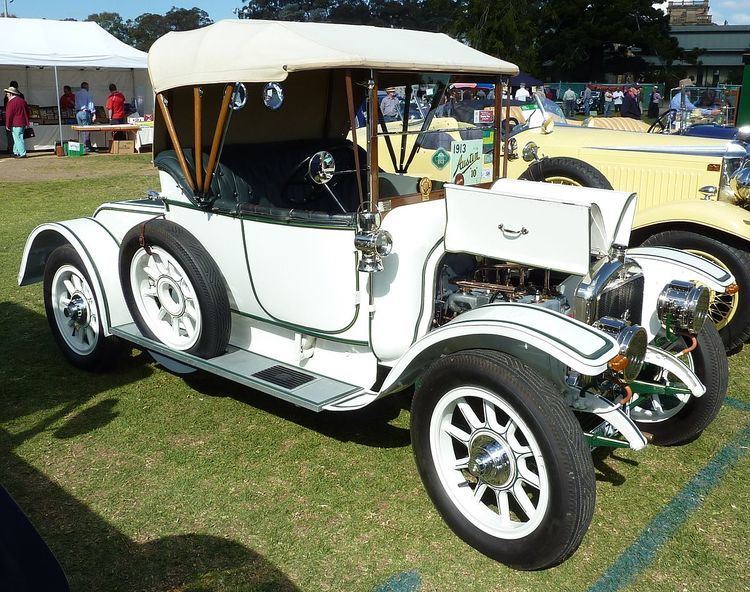Manufacturer Austin | Production 1910–1915 | |
 | ||
Body style Courier open 2-seateropen tourerSirdar phaetonchassis for bespoke body Engine 1125 cc vertical inline four cylinder1615 cc vertical inline four cylinder Transmission 3-speed gearboxAustin segmental cone clutch, 4-speed gearbox, propellor shaft with universal joints to live rear axle through bevel gears. | ||
The Austin 10 hp is a small car that was produced between 1910 and 1915 by the British car manufacturer Austin at their Longbridge, Worcestershire plant near Birmingham. 1,336 cars were made, 213 with the 1125 cc engine and 1,123 with the 1615 cc engine. Like the 1087 cc Austin 7 hp produced by both Austin and Du Cros's Swift Motor Company it was not very successful when sold with the small engine.
Contents
- Ten horsepower
- Fourteen horsepower
- Brakes suspension steering
- Road test
- Sirdar phaeton
- Production
- References
The original small 4-cylinder 1125 cc engine was replaced in 1913 with a larger 14.32 horsepower 1615 cc engine. Though rated for tax at 14.3 horsepower this larger engined model is sometimes referred to as the Austin 10/12.
In 1913, the 10 hp was the cheapest model in the Austin range, costing £260 for a chassis with tyres. The 10 hp (of 14.32-h.p.) was renamed 12-14 hp before midsummer 1915 but production was limited due to the war.
Ten horsepower
The high-speed type vertical straight four-cylinder engine has a bore and stroke of 63.5 mm × 88.9 mm (2 1⁄2 in × 3 1⁄2 in) giving a capacity of 1125 cc and an RAC and fiscal rating of 10.0 horsepower.
Fourteen horsepower
The new car with the 42 per cent larger engine was described in the Daily Mail newspaper in October 1912. Throttle and ignition levers are mounted on the top of the steering wheel, a foot accelerator is also being fitted. The petrol tank is mounted on the dash.
The high-speed type "T"-head vertical straight four-cylinder engine has a bore and stroke of 76 mm × 88.9 mm (3 in × 3 1⁄2 in) giving a capacity of 1615 cc and an RAC and fiscal rating of 14.32 horsepower. The cylinders are cast separately in spite of the general trend to monobloc engines. As before the engine is arranged to have interchangeable exhaust and inlet valves on opposing sides of the engine. Engine output was quoted as 12.5 brake horsepower at 1,000 r.p.m. and fully 16 brake horsepower on acceleration to 1,500 r.p.m.
There is a cooling fan for the honeycomb radiator and the engine incorporates a pump to ensure the flow of coolant. Lubrication is forced by pump to all the bearings. A float indicator shows the depth of oil in the crank chamber. Ignition is by High Tension Bosch magneto and may be manually advanced or retarded. The carburettor is by Claudel.
The thin steel-cone clutch engages with the Ferodo lined flywheel. The Ferodo linings are in sections which may be replaced individually. The gearbox is suspended at four points. It is operated by a hand lever controlled by a gate and now has four speeds forward and reverse.
Drive is taken by propeller shaft with universal joints to a live axle, the actual drive being by bevel gearing. The detachable steel wheels are by Austin-Sankey.
Brakes suspension steering
The usual foot (transmission) and hand (back wheels) brake levers are provided. The pressed steel frame is suspended by three-quarter elliptic springs at the rear and semi-elliptic in front. The steering gear incorporates a provision to take up wear.
Road test
John Phillimore of the Daily Mail took out a car with a four-seater body complete with hood and screen - there was no attempt to reduce weight. The engine's running he said was very pleasing giving the impression of an engine of much larger dimensions. No vibration was felt up to about 37 or 38 miles per hour when a slight but by no means annoying vibration appeared. The engine was very flexible in traffic though the sensitive throttle lever must be worked smoothly. The car tested had the old-type clutch and three-speed gearbox. Brakes are powerful and smooth but the hand lever for the wheel brakes is outside. Steering was stiff at low speed. The back axle was quiet, the only noise when running was a slight hum when using the indirect speeds.
The car's switch and oil gauge are mounted below the petrol tank on the dash where Phillimore considered they stood a good chance of getting severe kicks from passengers' feet. Prices were £240 or £250 for the chassis depending on wheelbase which may be 8 ft 3 in or 9 ft. The shorter body was priced at £55, the longer £65. Hood and screen were extra.
Sirdar phaeton
Austin's 10-h.p. four-seater phaeton was called Sirdar. It was supplied fitted with leather upholstery and horsehair cushions. A Cape hood was fitted and side curtains. There was a double folding glass screen with brass fittings, a spare wheel and tyre, Lucas paraffin side and tail lamps and Solar mirror lens acetylene headlamps with separate generator. A speedometer and mileage recorder, horn, tyre pump, lifting jack, kit of tools and accessories were all supplied.
